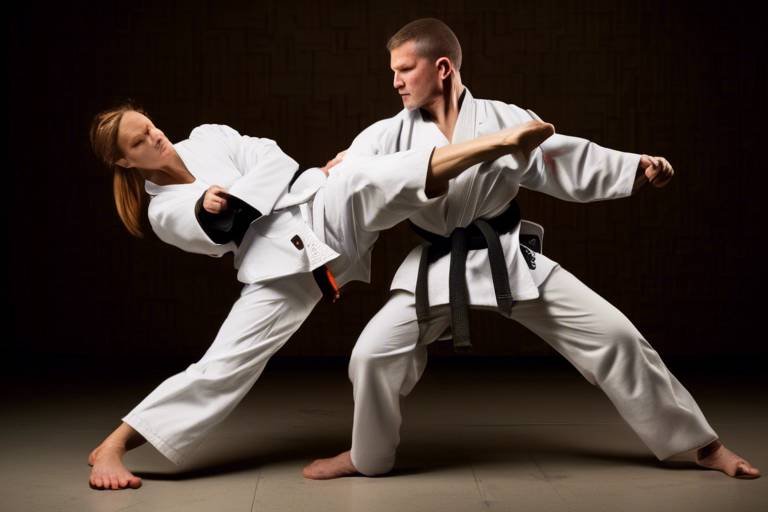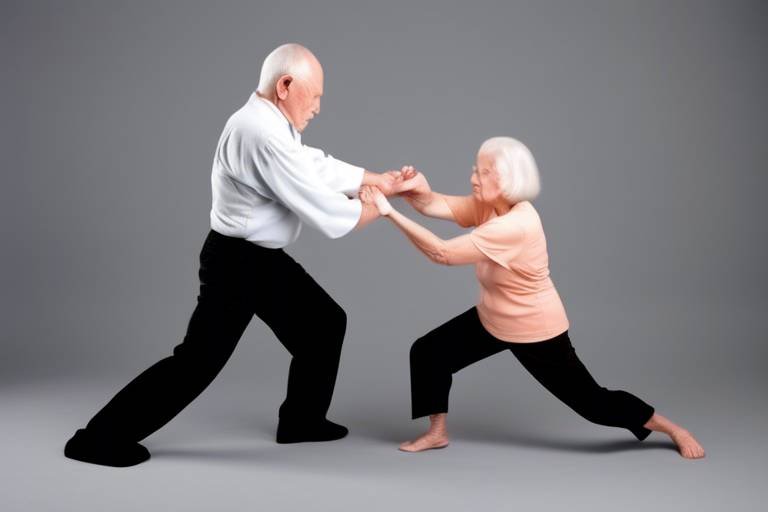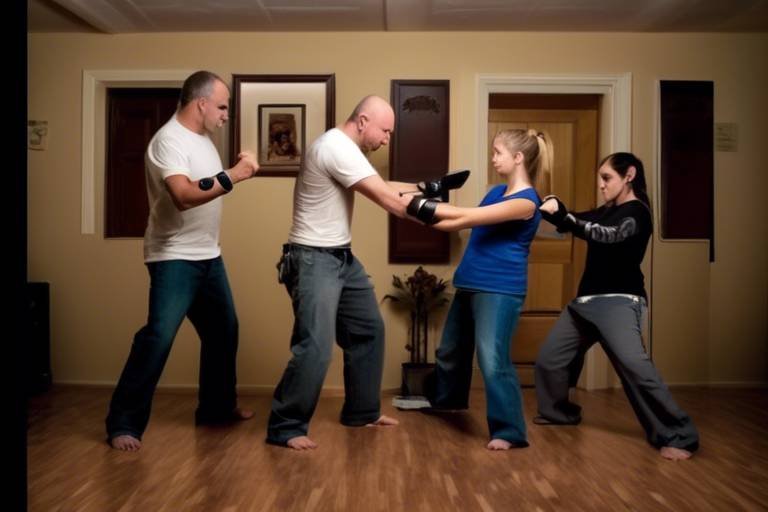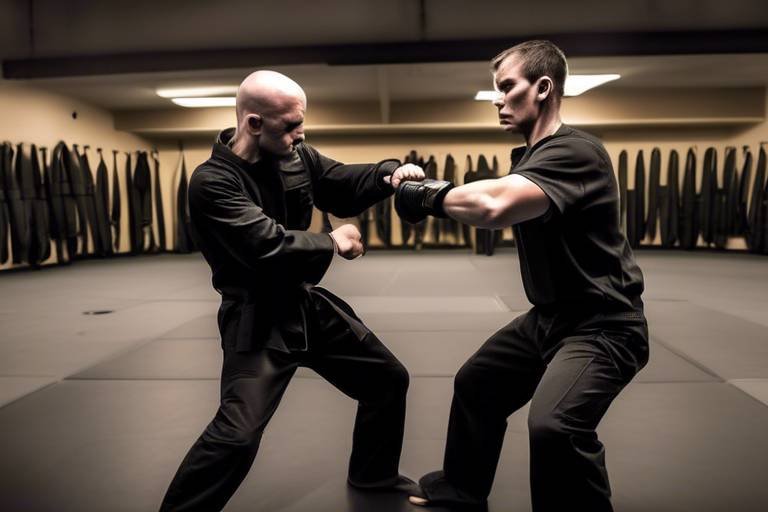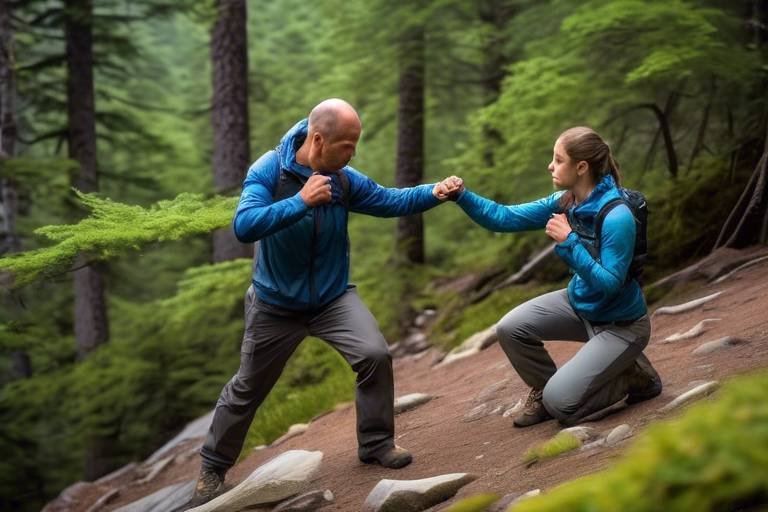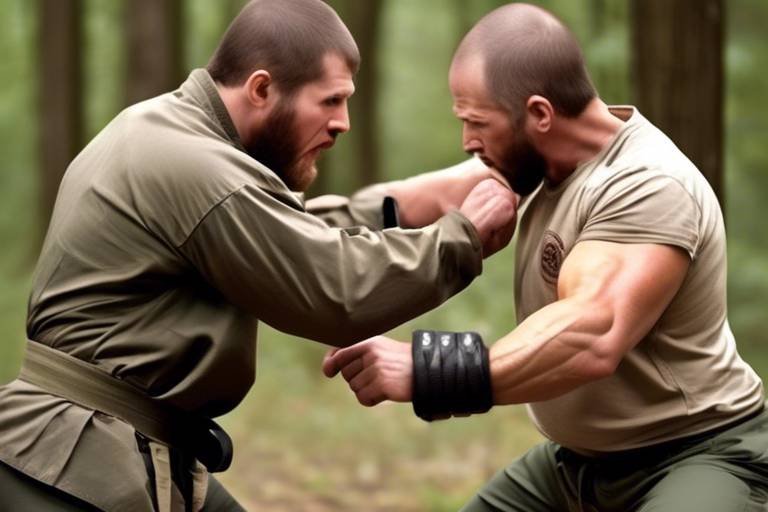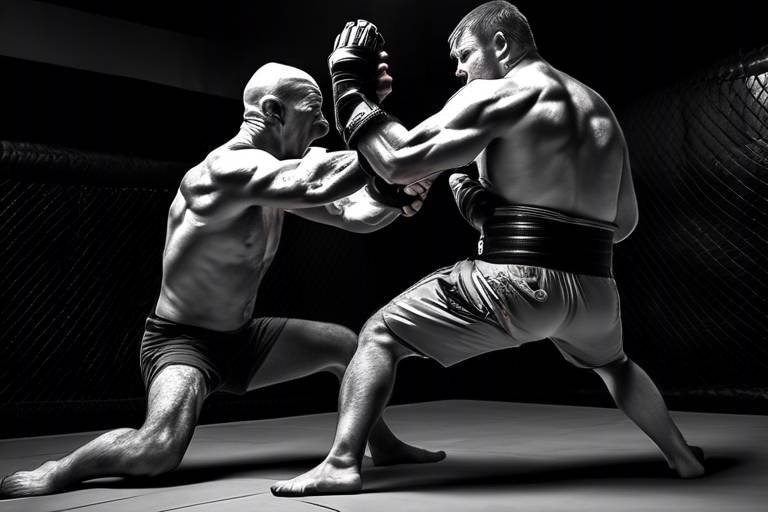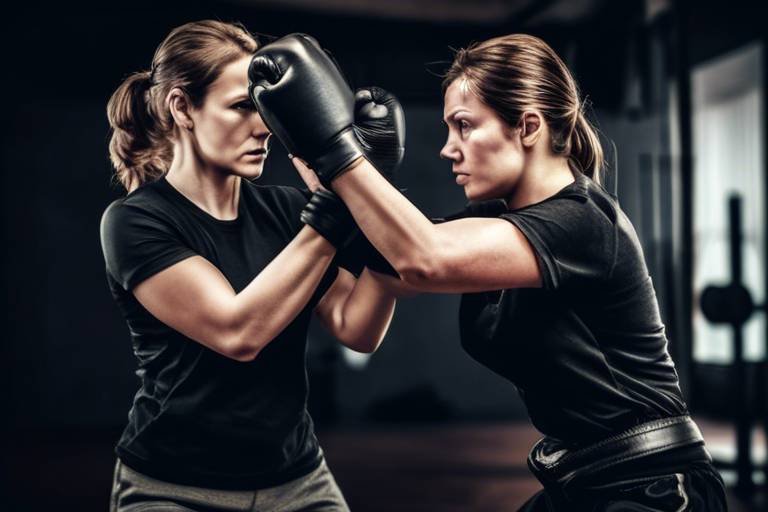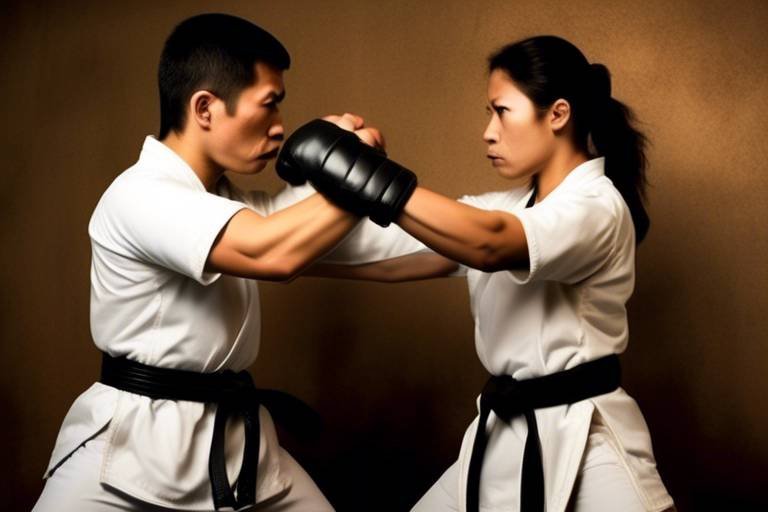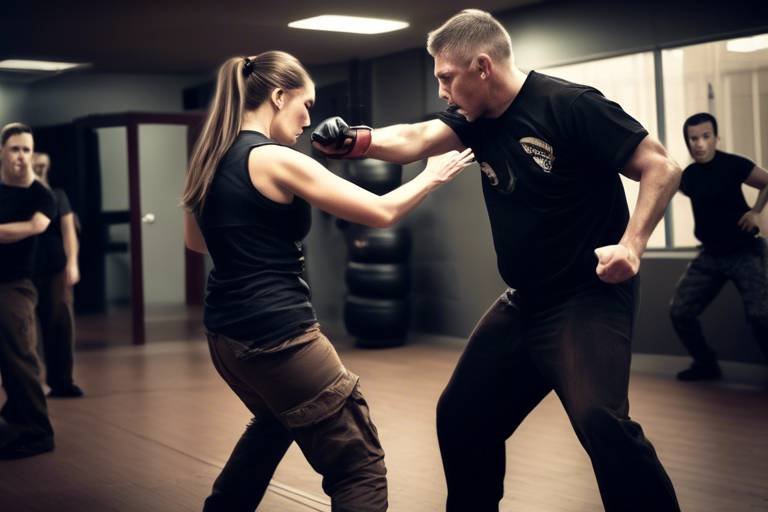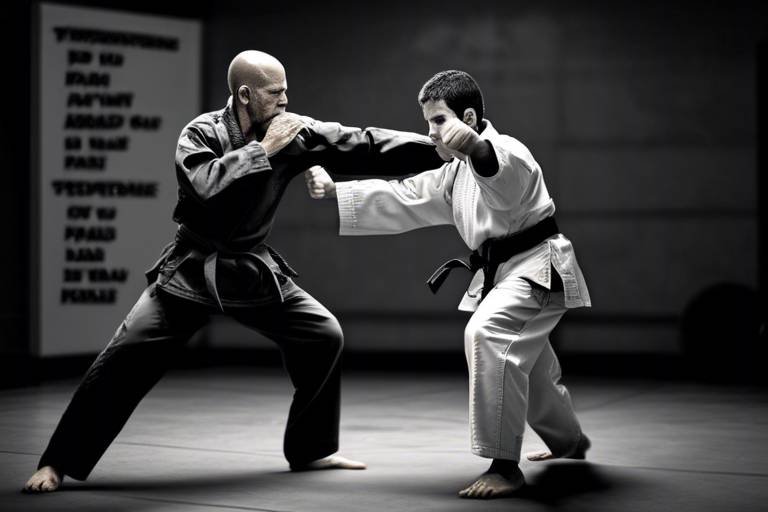The Role of Balance in Effective Self-Defense Techniques
In the world of self-defense, one element stands out as a cornerstone of effective techniques: balance. Imagine trying to stand on a tightrope without a safety net; your stability is everything. Just like that tightrope walker, a self-defense practitioner must maintain their equilibrium to react swiftly and effectively in confrontational situations. Balance is not just a physical attribute; it’s a mental state that allows you to assess your surroundings and respond appropriately. Whether you're facing an aggressive opponent or simply trying to navigate a crowded space, mastering balance can mean the difference between safety and vulnerability.
Balance is more than just standing firm; it involves a dynamic interplay of body mechanics, weight distribution, and posture. When you’re balanced, you’re not only less likely to be knocked down, but you’re also poised to deliver powerful counterattacks. The importance of balance can be illustrated through various self-defense scenarios, from the street to the dojo. In each of these situations, a solid foundation allows you to execute techniques with precision and confidence. So, how do we cultivate this essential skill? Let’s dive deeper into the mechanics of balance and explore the techniques that can enhance your stability and performance.
To truly grasp the significance of balance in self-defense, we need to look at its mechanics. Think of balance as the glue that holds together all the elements of your defensive strategy. In any altercation, maintaining control is crucial, and that control starts with your ability to stay balanced. When your body is aligned, your movements become more fluid, and your reactions are quicker. Imagine trying to catch a ball while standing on one leg; the challenge is immense. Similarly, if you’re off-balance during a confrontation, your ability to defend yourself diminishes significantly.
In self-defense, balance allows you to maintain a strong stance while being prepared to move. This is especially important when you need to evade an attack or create distance between you and an aggressor. The key takeaway here is that balance is not just about preventing falls; it’s about enabling effective action. The more you understand and practice balance, the more confident you will feel in your ability to protect yourself.
Now, let’s explore the scientific principles behind balance. At the core of balance are concepts like weight distribution, center of gravity, and body mechanics. These elements work together to create a stable platform from which you can operate effectively. Understanding how these factors contribute to your overall balance can significantly enhance your self-defense techniques.
Your center of gravity (CG) is the point at which your body’s mass is evenly distributed. It’s crucial to understand its position because it affects your stability. When your CG is low, you’re more stable, much like a well-balanced seesaw. Conversely, if your CG is high, you’re more likely to lose your balance. In self-defense, knowing how to adjust your stance based on your CG can greatly improve your performance. For instance, bending your knees slightly can lower your CG, making you more stable and ready to react.
Modifying your stance according to your center of gravity can enhance your balance dramatically. Here are a few stances that can help you improve stability:
- Wide Stance: Spreading your feet apart provides a strong base.
- Forward Lean: Leaning slightly forward can help you maintain momentum.
- Side Stance: Turning sideways can make it harder for an opponent to push you off balance.
Proper weight distribution is essential for maintaining balance. When you shift your weight correctly during defensive maneuvers, you can execute techniques more effectively. For example, if you’re preparing to throw a punch, transferring your weight from your back foot to your front foot can add power to your strike while keeping you grounded. It’s all about finding that sweet spot where your weight is evenly distributed, allowing for both offense and defense.
Dynamic balance refers to maintaining stability while in motion. In self-defense, this means being able to move, dodge, and counterattack without losing your footing. Developing dynamic balance is essential for enhancing your agility and responsiveness. Think of it as a dance; you must be light on your feet while also being ready to react. Training for dynamic balance can involve various drills that challenge your ability to stay upright while moving quickly.
Training methods specifically designed to improve balance are crucial for self-defense effectiveness. Incorporating balance drills into your routine can significantly enhance your skills and confidence. These exercises not only help you stay grounded but also prepare you for the unpredictable nature of real-world confrontations.
Here are some balance drills you can incorporate into your training regimen:
- Single-Leg Stands: Balancing on one leg while performing upper body movements.
- Heel-to-Toe Walk: Walking in a straight line while placing the heel of one foot directly in front of the toes of the other.
- Balance Board Exercises: Using a balance board to challenge your stability.
Understanding how balance applies in real-world self-defense scenarios is essential. For instance, if you find yourself in a crowded area and someone approaches aggressively, your ability to maintain balance can help you evade the attack or create distance. Likewise, in a grappling situation, having a strong center of gravity can prevent your opponent from taking you down. The techniques you learn in training are not just theoretical; they have practical applications that can help you stay safe in everyday situations.
Q: How does balance affect my self-defense skills?
A: Balance is critical as it allows you to maintain control and react quickly during confrontations. Without it, your ability to defend yourself is compromised.
Q: What are some simple exercises to improve balance?
A: Simple exercises include single-leg stands, heel-to-toe walking, and using a balance board.
Q: Can I improve my balance without a gym?
A: Absolutely! Many balance exercises can be done at home with minimal equipment.

Understanding Balance in Self-Defense
Balance is not just a fancy word thrown around in martial arts classes; it’s the cornerstone of effective self-defense. Imagine trying to stand on one leg while someone pushes you—without balance, you’re likely to topple over. In self-defense, maintaining your balance means you can react swiftly and effectively, whether that’s dodging an attack or delivering a counterstrike. It’s all about keeping your feet firmly planted while your mind remains agile.
When you think about balance, you might picture a tightrope walker gracefully navigating a thin line high above the ground. Just like that performer, self-defense practitioners must find their center. The mechanics of balance involve a delicate interplay of body posture, weight distribution, and muscle control. Each of these elements contributes to your ability to stay grounded in a chaotic situation. The more you understand how to leverage these mechanics, the more effective you’ll be when it counts.
In various self-defense scenarios, maintaining balance can make the difference between escaping an altercation and being overwhelmed. For instance, if someone attempts to push you, your ability to stay balanced allows you to pivot and escape rather than being thrown off your feet. This is where the concept of dynamic balance comes into play. It’s not just about standing still; it’s about being able to move fluidly while keeping your stability intact.
To truly grasp the importance of balance, let’s break it down into a few key aspects:
- Control: Balance gives you control over your body, allowing for precise movements.
- Reaction Time: A balanced stance enables quicker reactions to sudden movements or attacks.
- Power Generation: Proper balance allows you to generate more power in your strikes and defenses.
In summary, understanding balance is crucial for anyone looking to enhance their self-defense skills. It’s not merely about standing upright; it’s about mastering your body’s mechanics to respond effectively in high-pressure situations. So, the next time you think of self-defense, remember that balance is your unsung hero, quietly supporting your every move.

The Physics of Balance
Understanding the physics of balance is crucial for anyone looking to enhance their self-defense skills. Balance isn't just a physical attribute; it's a dynamic interplay of forces that allows practitioners to maintain stability while reacting to threats. When we talk about balance in self-defense, we are primarily referring to three key elements: weight distribution, center of gravity, and body mechanics. Each of these components plays a vital role in how effectively a person can defend themselves in a confrontational situation.
To break it down further, let's consider the center of gravity. This is the point in your body where your mass is evenly distributed in all directions. It’s like the fulcrum on a seesaw—if you can keep that point low and centered, you’ll have a much easier time maintaining your balance. When you’re standing upright, your center of gravity is typically located just above your hips. However, as you move or shift your posture, this point changes. Understanding how to manipulate your center of gravity can significantly enhance your ability to perform self-defense techniques without losing stability.
Knowing where your center of gravity lies allows you to optimize your stance and movements. For instance, when you adopt a fighting stance, bending your knees slightly and lowering your hips can help lower your center of gravity, making it harder for an opponent to knock you off balance. This adjustment is crucial in a self-defense scenario, as it enables you to remain grounded and responsive to incoming threats.
Modifying your stance based on your center of gravity is not just about standing still; it’s about being ready to move. When you adjust your stance, think of it as setting the stage for a dance. The better your foundation, the more fluid and powerful your movements will be. For example, a wider stance can enhance stability, while a narrower stance may allow for quicker lateral movements. Each stance has its advantages, and understanding when to use each can be the difference between being caught off guard or executing a successful defense.
Proper weight distribution is another essential aspect of maintaining balance. Imagine trying to balance a pencil on your finger; if your weight is unevenly distributed, the pencil will fall. The same principle applies in self-defense. When you're in a confrontation, distributing your weight evenly between your feet allows for quicker reactions and more power behind your movements. Techniques such as pivoting on the balls of your feet or shifting your weight from one leg to another can significantly enhance your balance during defensive maneuvers.
In summary, the physics of balance in self-defense is all about understanding how to manage your body's forces effectively. By focusing on your center of gravity, adjusting your stance, and mastering weight distribution techniques, you can create a robust foundation that enhances your stability and responsiveness. This knowledge not only improves your self-defense capabilities but also instills confidence, allowing you to face confrontational situations with a sense of control and poise.

Center of Gravity
The is a concept that plays a pivotal role in the realm of self-defense. Imagine your body as a seesaw; if the weight is evenly distributed, it balances perfectly. However, if one side is heavier, it tips over. In self-defense, understanding your center of gravity can mean the difference between standing firm against an attacker and being easily knocked off balance. This point in your body where gravitational forces act is crucial for maintaining stability during confrontations. The lower your center of gravity, the more stable you are, allowing you to respond effectively to sudden movements or attacks.
To visualize this, think about a tree in a storm. A tree with deep roots and a low center of gravity sways but doesn’t topple over, while a tall, spindly tree is more likely to break. In self-defense, your stance and posture should mimic that sturdy tree. By lowering your center of gravity through proper positioning, you can enhance your balance and readiness. This is particularly important when you need to react quickly, as a strong foundation allows for greater power and control in your movements.
When practicing self-defense techniques, it's essential to be aware of your body's center of gravity. For example, during a defensive maneuver, if you lean too far back or forward, you risk losing your balance and stability. Instead, aim to keep your weight centered over your feet. This not only improves your balance but also enhances your ability to execute techniques with precision and power.
Incorporating exercises that focus on your center of gravity can significantly enhance your self-defense capabilities. Below are some effective strategies to help you optimize your center of gravity:
- Stance Awareness: Practice various stances such as the horse stance or a low squat to find your optimal balance.
- Weight Shifts: Engage in drills that involve shifting your weight from one leg to another while maintaining a solid base.
- Core Strengthening: Strengthening your core muscles helps stabilize your center of gravity, making it easier to maintain balance during movements.
Ultimately, understanding and mastering your center of gravity is a fundamental aspect of effective self-defense. By focusing on this critical element, you not only enhance your physical stability but also boost your confidence in handling confrontational situations. Remember, a stable foundation is key to executing techniques successfully and ensuring your safety in any self-defense scenario.

Adjusting Your Stance
When it comes to self-defense, one of the most crucial aspects is your stance. Think of your stance as the foundation of a house; if it’s not solid, everything built on top of it can come crashing down. Adjusting your stance can dramatically enhance your balance, making you more stable and prepared to react in any situation. The key is to find a position that feels natural yet provides a robust base for movement and defense.
First and foremost, consider the width of your stance. A wider stance generally provides more stability, akin to a tree with deep roots; it can withstand the forces that come its way. However, it’s important to strike a balance—too wide, and you may find it challenging to move quickly. A good rule of thumb is to position your feet shoulder-width apart, allowing for both stability and mobility. This way, you can pivot or shift your weight easily, adapting to the dynamics of an encounter.
Next, let’s talk about foot positioning. Your toes should point slightly outward. This orientation not only helps in maintaining balance but also allows for quicker lateral movements. Imagine a sprinter poised at the starting line; their feet are positioned perfectly to launch them forward. Similarly, when you adjust your feet to point outward, you’re setting yourself up for a quick response, whether it’s to evade an attack or to make a defensive maneuver.
Another critical factor to consider is your body alignment. Your knees should be slightly bent, which lowers your center of gravity and enhances your stability. This bent-knee position is akin to a coiled spring, ready to unleash energy at a moment’s notice. Additionally, keep your hips square and your shoulders relaxed yet engaged. This alignment not only aids in balance but also prepares your body for movement, ensuring that you can react swiftly when the need arises.
Lastly, practice makes perfect. Regularly adjusting your stance during training can help you internalize these adjustments, making them second nature in real-world situations. Consider incorporating drills that focus on transitioning between different stances, which can significantly improve your adaptability and confidence. Remember, every confrontation is unique, and having a repertoire of stances at your disposal can be the difference between success and failure.
In summary, adjusting your stance is not just about standing still; it’s about creating a dynamic foundation that allows for movement, balance, and responsiveness. By focusing on width, foot positioning, body alignment, and regular practice, you can enhance your self-defense capabilities and feel more secure in any situation.
- Why is stance important in self-defense? A proper stance provides stability and allows for quick movements, making it easier to react to threats.
- How can I practice my stance at home? You can practice your stance by standing in front of a mirror, adjusting your width, foot positioning, and body alignment until you find a comfortable and balanced position.
- Is a wider stance always better? Not necessarily. While a wider stance can provide more stability, it may limit your mobility. It’s essential to find the right balance that works for you.
- What exercises can help improve my balance? Exercises like yoga, tai chi, or specific balance drills can significantly enhance your overall stability and coordination.

Weight Distribution Techniques
When it comes to self-defense, understanding weight distribution is not just a technicality; it’s a game-changer. Think of your body as a seesaw; if one side is heavier, it tips over. In self-defense scenarios, maintaining an even balance can mean the difference between successfully executing a technique and losing your footing. To effectively distribute your weight, you need to be aware of your body’s position relative to your opponent. For instance, if you find yourself in a grappling situation, shifting your weight towards your opponent can create leverage, allowing you to regain control.
One of the fundamental aspects of weight distribution is your stance. A solid base is essential for executing techniques effectively. A common mistake many practitioners make is standing with their feet too close together, which compromises their stability. Instead, aim for a wider stance that allows your body to distribute weight evenly. This not only enhances balance but also prepares you to react swiftly. For example, when preparing to block an incoming strike, your weight should be slightly shifted back to your rear leg, ready to spring into action.
Here are some key techniques to enhance your weight distribution:
- Lower Your Center of Gravity: Bending your knees slightly and keeping your hips low can significantly improve your balance. This posture allows you to absorb any incoming force more effectively.
- Shift Your Weight: Practice shifting your weight from one foot to the other. This helps you become more agile and responsive, essential traits in a self-defense situation.
- Engage Your Core: A strong core stabilizes your body and supports better weight distribution. Incorporate exercises that strengthen your abdominal and back muscles into your routine.
Moreover, consider practicing techniques in front of a mirror or with a partner. This not only helps you visualize your movements but also allows you to feel how your weight shifts during various techniques. By paying attention to how your body feels, you can make necessary adjustments to improve your balance and stability.
In summary, mastering weight distribution techniques is crucial for anyone interested in self-defense. By focusing on your stance, engaging your core, and practicing weight shifts, you can enhance your overall performance. Remember, it’s not just about throwing punches or executing kicks; it’s about maintaining control and balance throughout every movement.
Q: Why is weight distribution important in self-defense?
A: Proper weight distribution enhances your balance, allowing you to execute techniques more effectively and maintain control during a confrontation.
Q: How can I practice weight distribution techniques?
A: Incorporate drills that involve shifting your weight, adjusting your stance, and practicing movements in front of a mirror or with a partner to improve your awareness and stability.
Q: What role does my core play in weight distribution?
A: A strong core helps stabilize your body, making it easier to maintain balance and control during self-defense maneuvers.

Dynamic Balance in Movement
Dynamic balance is a crucial aspect of self-defense that often goes unnoticed. It's not just about standing still and looking tough; it's about being able to move fluidly while maintaining your stability. Imagine trying to balance on a tightrope while juggling—it's all about keeping your center of gravity in check while you're in motion. In self-defense situations, this concept becomes even more important. When you’re confronted with an attacker, the ability to shift your weight and pivot quickly can mean the difference between evading a blow and getting knocked down.
To develop dynamic balance, practitioners must engage in exercises that challenge their stability while they move. This might involve practicing footwork drills that require quick changes in direction or incorporating agility ladders into your training routine. For instance, when you’re practicing a kick or a punch, it’s essential to ensure that your weight is distributed properly. Think of it as a dance; if you’re off-balance, you’ll stumble, but if you’re grounded, you can execute your moves with precision and power.
One effective way to enhance dynamic balance is through the use of specific drills that focus on movement patterns. Here are a few examples:
- Shadowboxing: This allows you to practice your techniques while moving around, helping you get accustomed to shifting your weight.
- Footwork drills: Incorporate lateral movements and sudden stops to simulate real-life scenarios where you need to change direction quickly.
- Partner drills: Practicing with a partner can help you learn to maintain your balance while reacting to an opponent’s movements.
Incorporating these dynamic balance exercises into your training routine will not only improve your self-defense skills but also enhance your overall athleticism. You’ll find that as you become more adept at maintaining your balance during movement, your confidence in your ability to defend yourself will grow. Remember, the goal is to be as fluid and responsive as possible, allowing you to adapt to any situation that may arise.
In conclusion, mastering dynamic balance is akin to mastering the art of flow in self-defense. Just like a river that navigates around obstacles, a practitioner must learn to flow through movements while remaining grounded. By focusing on dynamic balance, you’ll not only improve your self-defense techniques but also empower yourself to handle confrontations with greater ease and confidence.
Q1: What is dynamic balance in self-defense?
A1: Dynamic balance refers to the ability to maintain stability and control while in motion. It's crucial for executing techniques effectively during confrontational situations.
Q2: How can I improve my dynamic balance?
A2: You can improve dynamic balance through specific drills such as shadowboxing, footwork exercises, and practicing with a partner to simulate real-life scenarios.
Q3: Why is balance important in self-defense?
A3: Balance is essential in self-defense because it enables you to react quickly and effectively, maintain control during movements, and execute techniques without losing stability.

Training for Balance
When it comes to mastering self-defense, is not just a suggestion—it's a necessity. Think about it: what good is a powerful punch or a swift kick if you can't maintain your footing? Balance is the unsung hero of self-defense techniques. It’s the bedrock upon which your skills are built, allowing you to react swiftly and efficiently in high-pressure situations. So, how do you train for balance effectively? Let’s dive into some methods that can help you stay grounded, both literally and metaphorically.
One of the most effective ways to improve balance is through targeted exercises that challenge your stability. These exercises can range from simple to complex, depending on your current skill level. For instance, practicing single-leg stands can significantly enhance your core strength and stability. You can start by standing on one leg for 30 seconds, gradually increasing the duration as you improve. This not only develops your balance but also engages your core muscles, which are crucial for maintaining control during a confrontation.
In addition to single-leg stands, incorporating dynamic movements into your training can further enhance your balance. Activities like yoga or tai chi focus on fluid movements that require you to maintain your center of gravity while shifting your weight. These practices teach you to adapt your body’s position in response to changes in your environment, which is vital during a self-defense scenario. Imagine trying to evade an attacker while also needing to maintain your balance—this is where these dynamic practices shine.
Another effective training method involves using balance boards or stability balls. These tools provide an unstable surface that forces your body to engage various muscle groups to stay upright. Regularly practicing on these devices can help improve your proprioception—the body’s ability to sense its position in space. This heightened awareness can be a game-changer when you're faced with unexpected movements during a self-defense encounter.
To give you a clearer picture, here’s a simple table showcasing some effective balance training exercises:
| Exercise | Description | Benefits |
|---|---|---|
| Single-leg Stand | Stand on one leg, hold for time. | Improves core strength and stability. |
| Balance Board | Stand on a balance board and maintain stability. | Enhances proprioception and muscle engagement. |
| Yoga/Tai Chi | Practice fluid movements and poses. | Increases flexibility and dynamic balance. |
Incorporating these exercises into your routine can yield significant improvements in your balance over time. However, consistency is key. Just like learning any new skill, regular practice is essential for mastery. Aim to dedicate a portion of your training sessions specifically to balance work, and you’ll likely notice a marked improvement in your overall self-defense capabilities.
Lastly, it’s important to remember that balance isn't just about physical stability; it’s also about mental composure. In a self-defense situation, staying calm and focused can greatly affect your ability to maintain your balance. Techniques such as deep breathing and visualization can help you remain centered, even when the stakes are high. By training both your body and mind, you’ll be better prepared to face any challenge that comes your way.
- How often should I train for balance? Aim for at least 2-3 times a week, incorporating various exercises to keep it engaging.
- Can I practice balance training at home? Absolutely! Many exercises, like single-leg stands and yoga, can be done in the comfort of your own home.
- What if I struggle with balance? Start with simpler exercises and gradually progress. Consistency is crucial, and improvements will come with time.

Balance Drills
When it comes to self-defense, balance is not just a luxury; it’s a necessity. Imagine trying to stand firm on a moving boat—if you don’t have your balance, you’re likely to end up in the water! The same principle applies in self-defense scenarios. To help practitioners develop this crucial skill, incorporating into your routine is essential. These drills not only enhance stability but also improve overall performance in confrontational situations.
One effective drill is the Single Leg Stand. This simple exercise involves standing on one leg for as long as possible while keeping the other leg raised. Not only does this drill challenge your balance, but it also engages your core muscles, which are vital for maintaining stability during a self-defense maneuver. Start with 30 seconds on each leg and gradually increase the time as your balance improves. To add a twist, try closing your eyes or moving your arms to make it more challenging!
Another fantastic drill is the Tree Pose, borrowed from yoga. Stand tall, shift your weight onto one leg, and place the foot of the other leg on your inner thigh or calf (avoid the knee). This pose not only enhances your balance but also promotes mental focus, which is crucial during high-pressure situations. Hold the pose for 30 seconds on each side, and feel the difference in your stability and confidence.
For those looking for a more dynamic approach, consider the Balance Beam Walk. Use a straight line on the floor or a low beam if available. Walk along this line, placing one foot directly in front of the other. This drill mimics the narrow stances often required in self-defense, forcing you to engage your core and maintain focus. To increase difficulty, try walking backward or sideways!
Incorporating these drills into your training routine can yield significant results. However, the key is consistency. Aim to practice these exercises at least three times a week. You’ll find that as your balance improves, so does your confidence and ability to react effectively in self-defense situations.
To sum it up, balance drills are an integral part of self-defense training. They not only enhance your physical stability but also prepare your mind for the quick decision-making needed in confrontational scenarios. So, whether you're training at home or in a dojo, make these drills a priority. Your future self will thank you for it!
- How often should I practice balance drills? It's recommended to practice balance drills at least three times a week for optimal improvement.
- Can balance drills help in other sports? Absolutely! Balance is a fundamental skill in various sports, from martial arts to gymnastics and even team sports.
- What if I struggle with balance? Start with simpler exercises and gradually progress to more challenging ones. Consistency is key, and you’ll see improvement over time.
- Are there any age restrictions for these drills? No, balance drills can be adapted for all ages and fitness levels. Always listen to your body and consult a professional if unsure.

Real-World Applications
When it comes to self-defense, understanding the practical applications of balance can make all the difference in a high-stress situation. Imagine walking down a dimly lit street when suddenly, a confrontation arises. Your ability to maintain your balance can mean the difference between successfully defending yourself or being thrown off your feet. In real-world scenarios, balance is not just a theoretical concept; it’s a crucial skill that can dramatically enhance your response to threats.
Consider a situation where an aggressor attempts to push you. If you are rooted firmly with a strong base, your center of gravity low and your weight distributed evenly, you can absorb that force without losing your footing. This stability allows you to respond effectively—whether that means countering with a defensive maneuver or evading the attack altogether. The principles of balance enable you to stay composed, making quick decisions that could potentially de-escalate the situation.
Moreover, balance plays a significant role in various martial arts and self-defense techniques. For instance, techniques such as hip throws or joint locks rely heavily on the practitioner’s ability to maintain their center of gravity while manipulating their opponent. If you’ve ever watched a judo match, you’ll notice how judokas use balance not only to execute throws but also to stay grounded during their opponent's attempts to regain control. This interplay of balance and technique is what makes these martial arts effective in real-life scenarios.
Let’s break down a few specific applications of balance in self-defense:
- Street Encounters: In an unexpected confrontation, being able to pivot quickly while maintaining your balance can create opportunities to escape or defend.
- Self-Defense Classes: Many self-defense courses emphasize balance training, teaching students how to position themselves to resist attacks effectively.
- Sports and Sparring: Athletes often practice balance drills to improve their performance and reaction times, which can be directly applied in self-defense situations.
In essence, balance is not merely about standing firm; it’s about being adaptable. For example, if you find yourself in a grappling situation, your ability to shift your weight and adjust your stance can help you maintain control over your opponent. This adaptability is vital, as attackers often try to exploit any moment of instability. Practicing balance techniques can also improve your overall physical fitness, enhancing your agility and strength, which are indispensable assets in any self-defense scenario.
Furthermore, understanding the dynamics of balance allows individuals to assess their surroundings better. Being aware of how your body interacts with the environment can lead to better decision-making during a confrontation. For instance, if you notice a slippery surface, you might choose to adjust your stance or approach to minimize the risk of falling. This awareness can be the key to avoiding dangerous situations altogether.
In summary, the real-world applications of balance in self-defense are vast and impactful. It’s not just about the techniques you learn but how you apply them in the heat of the moment. By honing your balance skills through training and practice, you equip yourself with the tools necessary to navigate confrontational situations with confidence and effectiveness.
Q: Why is balance important in self-defense?
A: Balance is crucial because it allows you to maintain control and stability during a confrontation, enabling effective responses to various attack scenarios.
Q: How can I improve my balance for self-defense?
A: You can improve your balance through specific exercises, drills, and by practicing various stances that enhance your stability and readiness.
Q: Are there specific martial arts that focus on balance?
A: Yes, many martial arts, including judo, karate, and Brazilian jiu-jitsu, emphasize the importance of balance in their techniques and training methods.
Q: Can balance training help in everyday life?
A: Absolutely! Improved balance can enhance your overall physical fitness, prevent injuries, and boost your confidence in various situations, not just in self-defense.
Frequently Asked Questions
- Why is balance important in self-defense?
Balance is crucial in self-defense because it allows you to maintain control over your body and effectively respond to an attack. When you have good balance, you can execute techniques with precision and stability, reducing the risk of falling or being overpowered by an assailant.
- How can I improve my balance for self-defense?
Improving balance can be achieved through specific training exercises and drills. Activities like yoga, martial arts, and balance-focused workouts can enhance your stability. Additionally, practicing stances and weight distribution techniques will help you optimize your balance in various self-defense scenarios.
- What role does the center of gravity play in self-defense?
Your center of gravity is the point where your body’s weight is evenly distributed. Understanding its position helps you adjust your stance to maintain better balance. When you know how to position your center of gravity, you can execute defensive moves more effectively without losing stability.
- Can dynamic balance be trained?
Absolutely! Dynamic balance can be developed through specific movement drills. Incorporating exercises that require you to shift your weight while moving—like agility drills or footwork patterns—will enhance your ability to maintain stability while in motion, which is vital in self-defense situations.
- What are some effective balance drills for self-defense?
Some effective balance drills include single-leg stands, balance beam exercises, and stability ball workouts. These drills not only improve your physical balance but also enhance your overall coordination and strength, making it easier to perform self-defense techniques.
- How does weight distribution affect my self-defense techniques?
Proper weight distribution is essential to maintaining balance during self-defense maneuvers. When your weight is evenly distributed, you can move fluidly and react quickly to threats. Techniques that focus on shifting your weight appropriately will help you stay grounded and ready to defend yourself.
- Can I apply balance techniques in real-world situations?
Yes, balance techniques are highly applicable in real-world self-defense scenarios. By practicing balance in various stances and movements, you’ll be better prepared to handle confrontations. Whether it’s dodging an attack or executing a defensive move, maintaining balance will enhance your effectiveness in critical situations.

